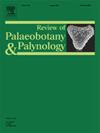Simulated charcoalification of Lycopodium spores: The usefulness of spore colour and chemistry for understanding the fossil record
IF 1.7
3区 地球科学
Q2 PALEONTOLOGY
引用次数: 0
Abstract
The fossil pollen and spore (sporomorph) record includes occurrences of darkened grains typically attributed to thermal maturation from geological processes. However, zones of sporomorph darkening and colour variability within samples sometimes coincide with mass extinction events. Although bimodal sporomorph coloration is relatively common, its abundance often increases markedly during such intervals. These observations have prompted alternative explanatory hypotheses suggesting either environmental stresses on parent plants or possibly reworking of sporomorphs. Here, we propose another explanation: variation in sporomorph colour and darkness may result from combustion in wildfires during large-scale ecological disturbances prior to fossilisation. To test this hypothesis, we investigate how pyrolysis might impact Lycopodium spore colour and darkness. Untreated, intact spores were combusted at temperature increments from 150 to 800 °C. We quantified spore colour by measuring red, green and blue (RGB) intensities and by converting them to Palynomorph Darkness Index (PDI) values. As well as measuring various physical attributes, we used Fourier-transform infrared (FTIR) spectroscopy to determine spore chemistry. As pyrolysis temperature increased, spores darkened, lost mass, and shrank. FTIR analysis revealed three distinct chemical states between non-pyrolysed spores and those heated to 375 °C. Physical changes correlated more strongly with temperature, forming different groupings than those of the chemical data, both partially explaining colour change due to pyrolysis. With these data, we establish a baseline for comparison in a future artificial thermal maturation study, which will help determine whether pre-diagenetic combustion could influence, and be preserved in, the physical and chemical properties of fossil sporomorphs.
石松孢子的模拟炭化:孢子颜色和化学对理解化石记录的有用性
化石花粉和孢子(孢子形态)记录包括暗粒的出现,通常归因于地质过程的热成熟。然而,样品中孢子形态变暗和颜色变化的区域有时与大规模灭绝事件同时发生。虽然双峰孢子形态的着色是相对常见的,但其丰度往往在这种间隔期间显著增加。这些观察结果提出了不同的解释假说,认为要么是对亲本植物的环境胁迫,要么可能是孢子体的改造。在这里,我们提出了另一种解释:孢子形态颜色和暗度的变化可能是在石化之前大规模生态干扰期间野火燃烧的结果。为了验证这一假设,我们研究了热解如何影响石松孢子的颜色和暗度。未处理的完整孢子在150至800°C的温度增量下燃烧。我们通过测量红色、绿色和蓝色(RGB)强度并将其转换为Palynomorph黑暗指数(PDI)值来量化孢子的颜色。除了测量各种物理属性外,我们还使用傅里叶变换红外光谱(FTIR)测定了孢子的化学性质。随着热解温度的升高,孢子变暗,失去质量,缩小。FTIR分析显示,未热解的孢子和加热到375°C的孢子之间有三种不同的化学状态。物理变化与温度的相关性更强,与化学数据形成不同的分组,两者都部分解释了热解引起的颜色变化。有了这些数据,我们为未来的人工热成熟研究建立了一个比较基线,这将有助于确定成岩前燃烧是否会影响和保存化石孢子形的物理和化学性质。
本文章由计算机程序翻译,如有差异,请以英文原文为准。
求助全文
约1分钟内获得全文
求助全文
来源期刊
CiteScore
3.50
自引率
21.10%
发文量
149
审稿时长
6 months
期刊介绍:
The Review of Palaeobotany and Palynology is an international journal for articles in all fields of palaeobotany and palynology dealing with all groups, ranging from marine palynomorphs to higher land plants. Original contributions and comprehensive review papers should appeal to an international audience. Typical topics include but are not restricted to systematics, evolution, palaeobiology, palaeoecology, biostratigraphy, biochronology, palaeoclimatology, paleogeography, taphonomy, palaeoenvironmental reconstructions, vegetation history, and practical applications of palaeobotany and palynology, e.g. in coal and petroleum geology and archaeology. The journal especially encourages the publication of articles in which palaeobotany and palynology are applied for solving fundamental geological and biological problems as well as innovative and interdisciplinary approaches.

 求助内容:
求助内容: 应助结果提醒方式:
应助结果提醒方式:


